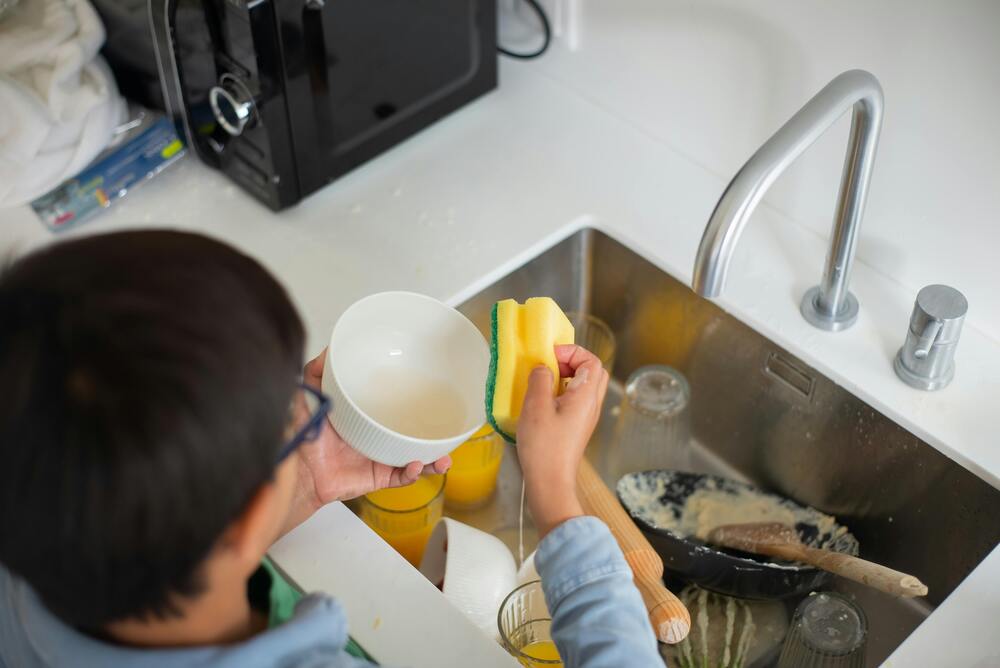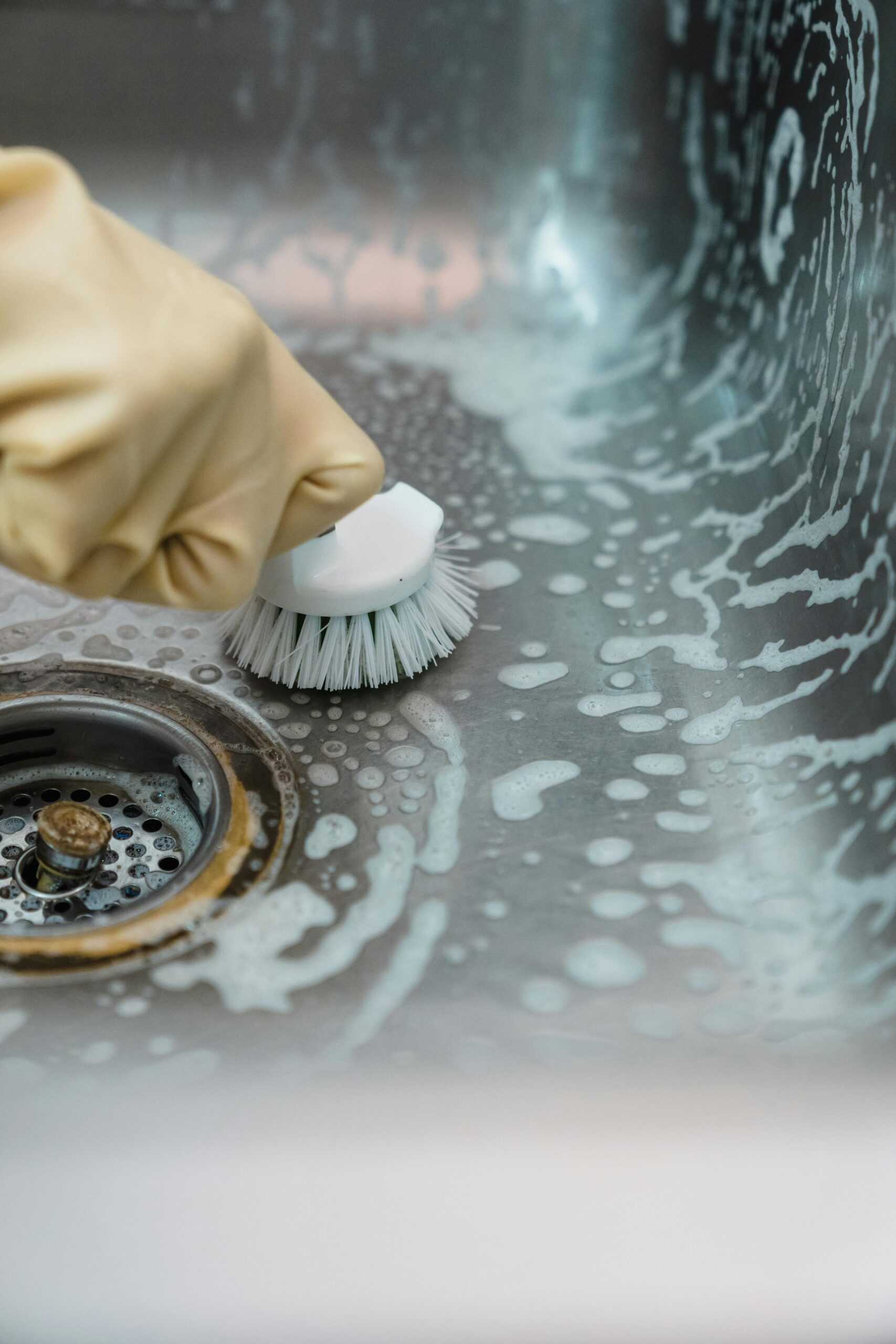The kitchen sink is one of the most frequently used areas in your home—used for washing vegetables, cleaning dishes, and even defrosting meat. But ironically, it’s also one of the dirtiest places in the house if not cleaned properly. Food residue, grease, and bacteria can quickly build up, leading to bad smells, unsightly stains, and potential health risks.
Whether your sink is stainless steel, ceramic, or composite, this guide will walk you through how to properly clean a kitchen sink like a seasoned house cleaning expert.
Summary:
- Why Cleaning the Kitchen Sink Matters
- Daily Sink Cleaning
- Weekly Deep Cleaning
- How to Clean Specific Sink Types
- Don’t Forget the Drain and Garbage Disposal
- Keep Your Sink Smelling Fresh
- Preventing Stains and Buildup
Why Cleaning the Kitchen Sink Matters

Even if your sink looks clean, it’s likely covered in bacteria. According to studies, kitchen sinks can harbor more germs than your bathroom. Some common culprits include:
- E. coli from raw meat juices
- Salmonella from unwashed produce
- Mould and mildew from standing water
- Grease and soap scum buildup from daily use
Proper cleaning helps:
✅ Prevent cross-contamination
✅ Eliminate odours
✅ Keep your kitchen hygienic
✅ Maintain the finish and lifespan of your sink
Daily Sink Cleaning (2–5 Minutes)
For day-to-day cleanliness, follow this simple routine:
What You’ll Need:
- Dish soap
- Non-abrasive sponge or cloth
- Hot water
Steps:
- Rinse the sink with warm water to loosen food debris.
- Add a few drops of dish soap to a sponge or cloth.
- Scrub all surfaces, including the sides, base, faucet, and drain area.
- Rinse thoroughly with hot water.
- Dry with a clean towel to prevent water spots and bacteria growth.
Tip: Don’t forget the sink edges and tap handles—these spots are often missed but collect grime quickly.
Weekly Deep Cleaning (10–15 Minutes)

Once or twice a week, give your sink proper clean with a deeper method to remove mineral deposits, stains, and lingering bacteria.
What You’ll Need:
- Baking soda
- White vinegar
- Lemon juice (optional)
- Toothbrush or soft scrub brush
- Microfibre cloth
Steps:
- Sprinkle baking soda all over the damp sink basin. It acts as a gentle abrasive and helps break down stains.
- Scrub with a damp sponge or brush, especially around the drain and edges.
- Pour white vinegar over the baking soda. It will fizz—this reaction lifts grime and helps sanitise.
- Let it sit for 5 minutes, then scrub again and rinse thoroughly.
- Wipe down the faucet and handles using a mix of vinegar and water or a disinfectant spray.
- Polish with a microfibre cloth for a shiny, streak-free finish.
Bonus Tip: Rub a slice of lemon over your sink for a fresh scent and extra shine—great for stainless steel!
How to Properly Clean a Kitchen Sink by Types

Stainless Steel Sinks
- Avoid steel wool or harsh abrasives.
- Rinse after every use to avoid water spots.
- Dry with a cloth to prevent mineral buildup.
Ceramic or Porcelain Sinks
- Be cautious with acidic cleaners (like vinegar) which can wear down the glaze.
- Use a soft brush and gentle cleaner like dish soap or baking soda paste.
Composite or Granite Sinks
- Avoid bleach and harsh chemicals.
- Clean using a mixture of baking soda and warm water.
- Apply a mineral oil treatment occasionally to maintain colour and sheen.
Don’t Forget the Drain and Garbage Disposal

To Clean the Drain:
- Pour half a cup of baking soda followed by half a cup of vinegar down the drain.
- Let it fizz for 10–15 minutes.
- Rinse with boiling water.
For Garbage Disposals (if installed):
- Drop ice cubes and lemon slices into the drain and run the disposal. This sharpens blades and freshens the smell.
Keep Your Sink Smelling Fresh
If your sink starts to smell bad, here are quick fixes:
- Drop lemon or orange peels into the drain and flush with hot water.
- Place a bowl of baking soda nearby to absorb odours.
- Use white vinegar weekly as a rinse to keep bacteria at bay.
Preventing Stains and Buildup
- Don’t leave food scraps sitting in the sink.
- Rinse after every use, especially after dealing with raw meat, dairy, or coffee grounds.
- Dry your sink after each clean to prevent watermarks or mildew.
Want a Truly Deep Clean? Let the Experts Handle It
Sometimes your sink—and the entire kitchen—needs more than a DIY clean. Built-up grime, mould in hidden crevices, or stubborn stains can be hard to tackle on your own.
That’s where Jim’s Cleaning NZ comes in.
Our team offers professional kitchen and home cleaning services, including disinfection services that ensure every surface is sanitised and spotless. Whether you’re moving out, spring cleaning, or just too busy to keep up—let us restore your kitchen to a fresh, hygienic state.
Final Thoughts
Your kitchen sink is the heart of your cleaning zone—so keeping it clean should be a top priority. With regular care and the occasional deep clean, you’ll protect your family’s health, extend the life of your sink, and keep your kitchen sparkling.
And if you ever need a helping hand, Jim’s Cleaning NZ is just a call away.
